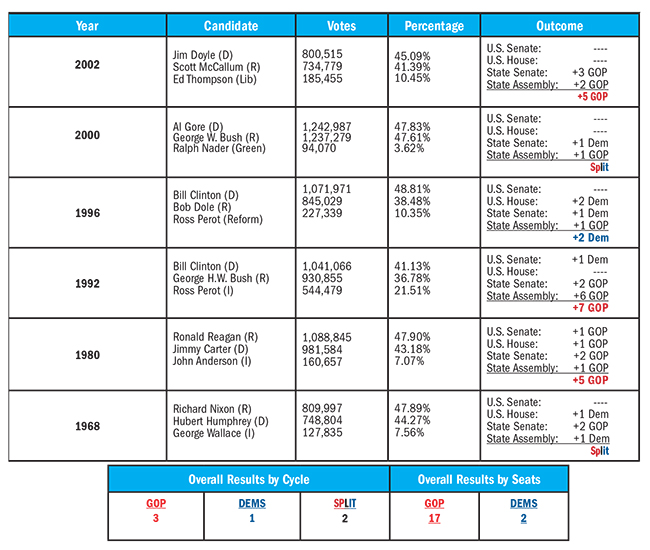Third-party candidates are often viewed as “spoilers.” Ross Perot was accused of keeping George H.W. Bush from being re-elected in 1992, and others believe Ralph Nader cost Al Gore the election in 2000. Indeed, both third-party candidates had a significant influence on the final outcome in these presidential elections.
But the top-of-the-ticket presidential race isn’t the only election that can be strongly influenced by a “significant” third-party candidate — congressional and state legislative elections can be impacted as well. These races tend to receive far less attention by the media, but a closer look at the down-ballot influence of significant third-party candidates illustrates the point.
Going back to and including the 1968 presidential race, there have been six election cycles with a significant third-party candidate on the ballot. “Significant” is defined as receiving at least five percent of the general election vote, with one exception for the 2000 election. Five of the six were presidential election cycles, and one was a midterm.
In order, here are the six elections and the third-party candidates:
- 1968, George Wallace (Independent)
- 1980, John Anderson (Independent)
- 1992, Ross Perot (Independent)
- 1996, Ross Perot (Reform)
- 2000, Ralph Nader (Green)
- 2002, Ed Thompson (Libertarian)
A breakdown of the down-ballot results from these six election cycles clearly illustrates that Republicans have disproportionately benefited from strong third-party candidates on the top of the ticket in Wisconsin over the last 47 years. Of the six election cycles, Republicans benefited in three, Democrats in one, and the parties split the difference in two. Over the six election cycles, the GOP netted 17 additional seats vs. two for Democrats. The chart on the next page highlights the advantage for Republicans over time.
What the numbers show
GOP as the big winners: Over the six election cycles with significant third-party candidates at the top of the ticket, Republicans have been the big winners down the ballot. The GOP has gained a net 17 seats vs. two for the Democrats. Even more impressive is the fact that Democrats carried the top of the ticket in Wisconsin in four of the six elections: 1992, 1996, 2000 and 2002.
Presidential elections draw third parties: Most third-party candidates of consequence run in presidential election years. Since 1968, five of the six candidates ran in the presidential cycle: 1968, 1980, 1992, 1996 and 2000. Only one of the six elections, 2002, was a midterm.
Top three influential third-party candidates: The three most influential third-party candidates in Wisconsin in 47 years were John Anderson in 1980, Ross Perot in 1992 and Ed Thompson in 2002. In all three elections, the two major party candidates were relatively close, with the third-party candidate running above five percent of the total vote — especially Perot in 1992.
Most third-party candidates are center-right: Of the six significant third-party candidates, four would be considered center-right: Anderson in 1980; Perot in 1992 and 1996; and Ed Thompson in 2002. Some might include George Wallace in this category, but Wallace was a southern Democrat governor who ran as an Independent in 1968. He was certainly not considered a liberal Democrat by either party.

Will a third-party candidate emerge in 2016?
So why, you might ask, is this discussion about a third-party candidate running in 2016 necessary? Hasn’t Donald Trump already pledged not to run as an Independent candidate if he fails to receive the GOP nomination? Yes, Trump has ruled it out — for now. He has also shown a propensity to change his mind.
And, according to Kevin Cirilli of The Hill, “the conditions appear ripe for a candidate to launch a bid from outside of the Democratic and Republican parties, with voters showing a deep dissatisfaction with Washington and relative outsiders dominating the crowded GOP field.”
If a significant third-party candidate enters the presidential race in 2016, the top of the ticket won’t be the only election to watch in Wisconsin.
Joe Murray is Director of Political and Governmental Affairs for the WRA.